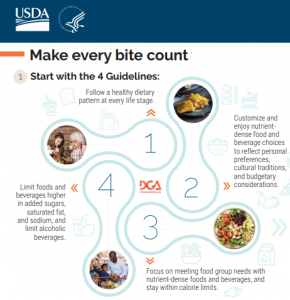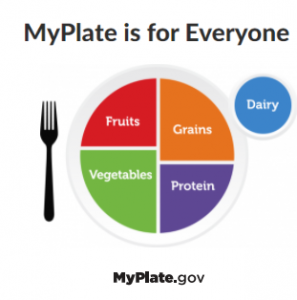Introducing the NEW Dietary Guidelines for Americans 2020-2025

On December 29, 2020, the U.S. Department of Agriculture (USDA) and the Department of Health and Human Services (HHS) released the latest U.S. Dietary Guidelines for Americans for 2020-2025. Every five years, these science-based guidelines are updated to offer the most current advice on “what to eat and drink to promote health, reduce risk of chronic disease, and meet nutrient needs.”
Key message – Make every bite count!

Americans’ health is suffering. According to the USDA, 6 in 10 adults are living with chronic illness, including type 2 diabetes, cardiovascular disease and osteoporosis that are often related to poor-quality diets. Following the Dietary Guidelines can help improve Americans’ health and it’s never too late to start dietary improvements. People at any stage of life can make every bite count and benefit from changing to more nutrient-dense forms of foods and beverages.
How are Dietary Guidelines used?
The US Dietary Guidelines have a significant impact on nutrition in the United States. The Dietary Guidelines form the basis of all federal nutrition policy and programs including nutrition resources. They also guide local, state, and national health promotion and disease prevention initiatives. The Dietary Guidelines are adapted by health professionals to meet specific needs of groups and individuals.
What’s new and what’s the same?
Here’s a snapshot of what’s new and what’s not in the USDA Dietary Guidelines 2020-2025 and what it means to people and businesses.
- NEW – 4 overarching Guidelines in the 2020-2025 edition
- Follow a healthy dietary pattern at every life stage.
- Customize and enjoy nutrient-dense food and beverage choices to reflect personal preferences, cultural traditions, and budgetary considerations.
- Focus on meeting food group needs with nutrient-dense foods and beverages, and stay within calorie limits.
- Limit foods and beverages higher in added sugars, saturated fat, and sodium, and limit alcoholic beverages.

- NEW – Guidance across all life stages now includes infants and toddlers.
From pregnant and breastfeeding mothers to older adults, nutrition advice is provided in the Dietary Guidelines for all life stages. The edition also emphasizes that it is never too early or too late to eat healthy!- For first time ever the guidelines include advice for children less than 2 years of age. This will help parents know how to start their infants and toddlers out with a healthy diet. Specific recommendations include:
- Introduce potential food allergens including eggs, peanuts and dairy to children early to help reduce the risk of developing food allergies.
- Avoid added sugars for infants and toddlers.
- NEW – Call to action: ‘Make every bite count’ with same 5 food groups and ‘MyPlate’ modelUSDA continues to use 5 food groups including dairy, unlike the Canadian Food Guide. Both Food guides recommend half the plate be filled with vegetables and fruit. Here is how the key consumer messages appear based on the new guidelines ‘Small Changes Matter, Start Simple’ resource:
- Make your plate half fruits and vegetables. Focus on whole fruits & vary your veggies.
- Make half your grains whole grains.
- Vary your protein routine.
- Move to low fat or fat free dairy milk or yogurt (or lactose free dairy or fortified soy versions)

Source: Dietary Guidelines for Americans, 2020-2025 , Consumer Brochure https://www.dietaryguidelines.gov/sites/default/files/2020-12/DGA_2020-2025_StartSimple_withMyPlate_English_color.pdf
- SAME – Key recommendations limit saturated fat, added sugars, sodium and alcohol
- Limit saturated fat to less than 10% of calories per day starting at age 2.
- Limit added sugars to less than 10% of calories per day for ages 2 and older; Avoid added sugars for infants and toddlers.
- Limit sodium intake to less than 2,300 mg per day (or even less if younger than age 14).
- If consumed by adults, alcoholic beverage guidance remains the same as previous years:
- 2 drinks or less per day for men and 1 drink or less a day for women. Pregnant women should not drink alcohol. Some experts are disappointed because the Scientific Advisory? Committee recommended further limiting alcohol intakes to just one drink a day for both men and women however this was not reflected in the final guidelines.
- SAME – Lack of mention about food insecurity and food systems.
Some food and nutrition advocates were hoping to see guidance on sustainably, climate change and information about food systems including activities involving the production, processing, transport in addition to the consumption of food. The Dietary Guidelines received some criticism for these exclusions.
The bottom line:
This is a comprehensive 164-page guidance document on what the average American should eat and drink to promote health and prevent chronic disease. For most people the takeaway from these guidelines should be forming healthy dietary patterns. “For lifelong good health, make every bite count with the Dietary Guidelines for Americans”.
Consult with Registered Dietitian to discover what the guidelines mean for your nutritional requirements, personal health and wellness or your food and nutrition business.
Want to discover more about how to make the Food Guide work for you and your business? Contact us now for a presentation / workshop.
Written by: Lucia Weiler, BSc, RD, PHEc, Co-Founder Nutrition for NON-Nutritionists